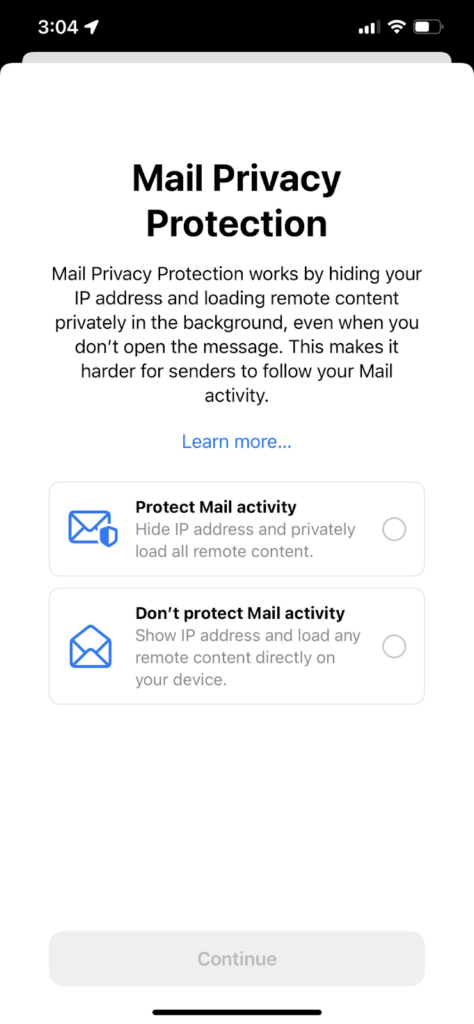- Apple’s New Email Philosophy
- “Hide My Email”
- How Does The New Protection Program Impact My Email Marketing Strategy?
- Open Rates
- Personal User Data
- Click-to-Open Rates
- Resend to Non-Openers
- What’s Not Changing?
- Building a Productive Email Marketing Campaign During the High-Privacy Pandemic
- What About Automation? Is It Still Relevant?
- Personalization & Brand Awareness
- Summing Up
Apple’s New Email Policy: What’s Going to Change and How to Build an Effective Email Marketing Campaign During a High-Privacy Era
August 30, 2021 15 min. read

Contents:
Try AI-Driven Insights
Monitoring for Free
Discover new business ideas and growth opportunities using
our AI-powered insights monitoring tool
Sooo…the rumor is true: Apple updated their mail policy. In the fall of 2021, the rules got stricter, guaranteeing a completely new marketing landscape for big and small businesses. What exactly is going on?
When it comes to users’ personal data, they demand higher privacy — some get annoyed by never-ending targeted ads while others are simply paranoid the big brother is watching them. Whatever the reason, people no longer want the system to know what and when they do on the Internet.
As a logical response to this request, folks at Apple have updated the company’s confidentiality policy. Starting with iOS 14.5 and further versions, apps now have to ask permission before using pretty much any piece of a user’s private data.
It doesn’t end there, though. In the fall of 2021, Apple also changed its mail policy. Given that Apple devices were responsible for more than 50% of email opens in 2021, there’s a little something to take note of.
So what exactly is going to change?
Apple’s New Email Philosophy
In a nutshell, the brand gave its users more freedom and control over what kind of information could be seen by the system. Just like with the app policy, iOS folks are then able to either allow or forbid the algorithms from seeing if, when, and from what device their emails have been opened.
The thing was, to gather information from recipients in the past, marketers used the so-called invisible tracking pixels — small images loaded when a user opened a letter. This had helped marketers see that the email had been opened, what kind of device was used, and its location at the opening time.
Well, the new iOS 15 basically canceled that functionality because, as with upcoming updates, they would be loaded remotely in the background. That means that you don’t spot your pixels being loaded (and your emails being opened) regardless of whether a user actually clicked on the letter or not. Yup, email opens could no longer be used to measure performance.

Credits to Ryan Jones
“Hide My Email”
This is another novelty introduced that fall. Basically, Apple allows users to stay anonymous by generating “unique, random email addresses” that clients can use when signing up for a newsletter or filling out an application form.
The letters, however, are still forwarded to a user’s personal inbox. This way, users get the best of both worlds (data privacy & inbox packed with wanted emails). At the same time, marketers suffer from extra anonymity and a lack of properly segmented audiences.

Credits: Apple
How Does The New Protection Program Impact My Email Marketing Strategy?
Although we can’t speak for all people, it’s safe to say that when most users are offered a chance to opt out of having their data tracked, they take it. And, as the mail policy is just as popular as the previous app data tracking update, some things are definitely changing for marketers. Let’s get more specific.
Open Rates
As I said above, email data is automatically pre-loaded by Apple whether a user opened the email or not. That is, the open rates of your emails haven’t been so reliable since the iOS 15 launch, so when you see your open statistics suddenly move up in a couple of months – don’t trust your eyes.
The open rate factor comes first and foremost as it paves the way to all further email marketing changes. We’ll get to that in a sec.
Personal User Data
As a part of their high-privacy mail campaign, Apple closed access to some data regarding each user’s online activity. We’re talking about:
• What type of device was used to open the letter;
• Specific time the email was opened;
• The precise location where the letter was opened;
This data helped marketers deliver personalized and relevant emails in the past, so there was a high chance that with the above-mentioned info being off-limits, users would be loaded with tons of irrelevant and annoying ads.
Click-to-Open Rates
Open rates aren’t the only crucial metric factor when it comes to email marketing. People can open your letters and forward them to a spam folder the next second. What also matters is whether they press on active links inside the email. If yes – then your content is clickable and exciting enough. If not – there’s still room for improvement.
To measure the clickability of your letters in the past, marketers used a metric called click-to-open rate (CTOR) – the number of clicks your email gets divided by the number of opens. With Apple’s new mail privacy settings, your CTOR is automatically decreased, which means you cannot rely on it anymore.
Good thing we can still count on the total clicks metric – the total number of recipients that clicked on a link in your letters. This means that you can still compare the amount of clicks in different (but same-size) campaigns and see which ones are best-performing.
As I’ve said, certain email features become less trustworthy as a result of open rates losing their credibility. Specifically:
A/B Subject Line Testing
What A/B subject line testing does is send out emails with two different subject line versions to a small share of your audience. Then, the one which gets more unique opens wins and is automatically sent to the rest of your email list.
Can you imagine how hard it is to determine which subject line is catchier now that the open rates are so unreliable? Exactly.
Email List Segmentation
You are still able to segment your audience, only kind of differently now. Since open rates are off the table, the new metric suggested for segmenting your audience is…drum roll…click rates.
Let’s say that in the past, you created a segment for your “most engaged subscribers” after checking how often they open your emails. What you’ll want to do now is look at the total click rates of your mail campaign and identify your “most engaged” subscribers based on how often they click on links inside your emails. Not a drastically different approach, right?
Automated Email Series
Automated email series are typically based on open rate triggers. In other words, when someone opens your email, the system automatically sends the user a follow-up letter.
As you may have already guessed, iOS 15 made it impossible to use open-based triggers for automated email series because Apple Mail shows an artificial number of opens for your letters. How to deal with automated email series now? Read on! 🙂
Resend to Non-Openers
Typically, this method allows automatically resending emails to recipients who didn’t open your letter the first time — after a certain time, of course. But since your letter will be reported as having been opened every time, users will simply not get your letter the second time. That is, they won’t get to read it, click links in the email and get acquainted with your brand (well, hello, low conversions).
What’s Not Changing?
At this point, you may be thinking, “Gosh, here we go again! So many changes I’ll have to get used to!” And yeah, the email marketing landscape definitely won’t be the same. But that doesn’t mean the world is turning upside down and everything will change. Some things — actually, a lot of things — will stay the same.
During this revolutionary time, you should keep in mind that your final goal was never to increase the open rates of your emails — just like before, your priority is to boost revenue, attract warm leads, and gain loyalty from your existing audience. And the good news is that it’s still pretty achievable — if you know what to do.
So what’s the antidote to this data protection disease? And how should you deal with the new rules, all the while maintaining top-notch customer retention?
Building a Productive Email Marketing Campaign During the High-Privacy Pandemic
The best way to adjust to the new reality is to shift your mindset. We mean, rethink the way you measure how successful or poor your email marketing campaign is. There’s no point in relying solely on the open and click rates of your statistics. After all, they weren’t the best factors in measuring the success of your business to begin with (they aren’t even among the top five ?).
We’re not saying click rates are unreliable — they’re still quite reliable. But don’t limit yourself to just this metric (unless your ultimate goal is to get many leads clicking links in your emails). Instead, focus on other metrics. Here’s what we mean:
• Overall ROI — calculate how much you earn from every dollar invested in email marketing and go from there — is it worth it?
• Conversions — count how many leads perform a specific action (like making a purchase, buying a demo etc.). The percentage of conversion rates will help you clear up whether your offer is relevant and tempting enough;
• Forwarding — check how many recipients share your emails with their gang, raising your brand awareness;
• List Growth — who rates higher: people who join your email list or those who click “Unsubscribe”?
• Click Rate — self-explanatory. 🙂
As you can tell, there are many ways to measure the performance of your mail campaign besides open rates. And even with click rates, remember that it’s just a helpful tool in reaching your goal and not the goal itself. Always keep in mind that your overall business objectives should align with your email marketing strategy.
What About Automation? Is It Still Relevant?
Luckily, business automation isn’t going anywhere. AI-driven platforms are still great for a wide variety of use cases when it comes to digital promotion — and email marketing is on the list, too. Only there’s a slight shift in strategy. 🙂
Yes, open rates don’t count anymore, but that doesn’t mean other triggers are invalid. Instead of open-based triggers, try using the following criteria for your email automation:
• Clicks (here we go again);
• Time (customer receives a second email after a certain number of days);
• Behavior (typical e-commerce behavioral triggers: product updates emails, abandoned cart emails, etc.);
• Date (special event emails, including anniversary, birthday, national holiday and other events).
As for other opportunities for marketing automation, they’re still in stock, too! Just like that, you can count on AI when it comes to generating unique and relevant ad creatives, collecting micro-segmented warm recipient lists, and scaling your campaigns with a single click.
Personalization & Brand Awareness
Although during this high-privacy era, it’s super challenging to customize your content for each individual user, at the same time, personalization has never been more vital. After all, how else can you grab your recipient’s attention?
Make sure you adjust your approach to each segment (and, preferably, user) individually. This involves all aspects of a successful email marketing campaign, from subject lines to ad creatives.
Also, pay special attention to your preheaders (the first few lines of your email letter), the “from” name (make sure the reader can recognize your brand name right away) and, of course, the subject line (make sure it’s personalized enough). Help your reader open and read your email!
Summing Up
If you think about it, the new data privacy protection updates are actually even good for us. Why? Simply because they remind marketers and entrepreneurs to focus on their ultimate goals instead of chasing useless KPIs. Plus, as a result of the new iOS 15, we should expect nothing but improved personalization, more protected webspace and a ton of saved time for marketers (thanks, AI).
Anyways, good job, Apple!
More useful content on our social media:
